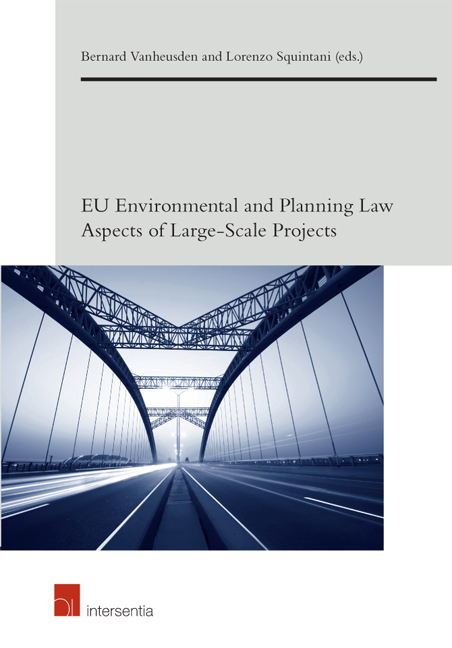Book contents
- Frontmatter
- Contents
- Introduction
- Part I General
- Chapter 1 Environmental Aspects of State Aid for Energy Investment Projects
- Chapter 2 The New 2014 Regulation on Noise-Related Restrictions at EU Airports Help or Hurdle to Noise Management?
- Chapter 3 The EU and the Participation of Civil Society in Large Projects
- Chapter 4 From Host to Investor: Enhancing the Sustainability of CDM Forest Carbon Projects
- Part II Public Participation
- Part III Environmental Impact Assessment
- Part IV Water
- Part V Nature
- Part VI Land Use
- Conclusion: Reconciling Conflicting Values: A Call For Research on Instruments to Achieve Quasi-Sustainability
Chapter 3 - The EU and the Participation of Civil Society in Large Projects
from Part I - General
Published online by Cambridge University Press: 21 September 2018
- Frontmatter
- Contents
- Introduction
- Part I General
- Chapter 1 Environmental Aspects of State Aid for Energy Investment Projects
- Chapter 2 The New 2014 Regulation on Noise-Related Restrictions at EU Airports Help or Hurdle to Noise Management?
- Chapter 3 The EU and the Participation of Civil Society in Large Projects
- Chapter 4 From Host to Investor: Enhancing the Sustainability of CDM Forest Carbon Projects
- Part II Public Participation
- Part III Environmental Impact Assessment
- Part IV Water
- Part V Nature
- Part VI Land Use
- Conclusion: Reconciling Conflicting Values: A Call For Research on Instruments to Achieve Quasi-Sustainability
Summary
INTRODUCTION
Large projects, such as for infrastructure, industrial installations, power plants or for other purposes, have increased considerably in number in the last decades. The reasons for this development are greater mobility of persons, increased trade, globalisation, more free time and greater welfare. In Europe, the existence and the activities of the European Union have largely contributed to this development. In particular, the policy decision in the early 1990s to develop trans-European networks in the area of energy, transport and telecommunication played an important role in this regard. The EU provisions on the Structural Funds provided for specific provisions for ‘big projects’ which were defined as having an investment volume of more than 25 million euros. Other projects to be mentioned are nuclear power plants, military projects, projects for sport events – e.g. Olympic Games (London 2012, Sochi 2014), motorsport races, international championships – and leisure installations such as Disneyland, Eurovegas, or pleasure parks, festivals and concert halls.
The following lines will examine some environmental problems linked to such projects, in particular the transparency in the decision-making and the possibilities for civil society to participate in this process.
LARGE PROJECTS IN EU ENVIRONMENTAL LAW
The environmental policy in Europe developed since the early 1970s a particular concern for large projects. This process was in particular driven by the activities and measures of the European Union. However, since the fall of the Berlin wall, the financial support given to projects in non-EU countries by the European Investment Bank (EIB) and the European Bank for Reconstruction and Development (EBRD), later on the accession negotiations led to a considerable spill-over of EU policies and legislative measures on non-EU countries; this process is not yet finished, if one thinks of the Balkan States or countries such as Ukraine or Moldavia.
The first measure to mention is the requirement of an environmental impact assessment (EIA) for large infrastructure and other projects which was introduced in 1985, and subsequently extended and fine-tuned. This EIA required an examination of the direct and indirect, secondary, cumulative, short, medium and long-term, permanent and temporary, positive and negative effects which a project might have on the environment. The impact assessment has to be made, before the permit for the realisation of the project is granted.
- Type
- Chapter
- Information
- Publisher: IntersentiaPrint publication year: 2016



